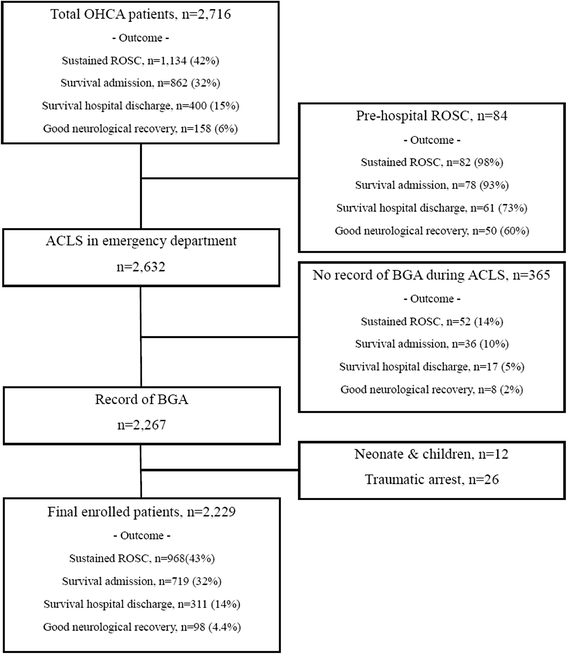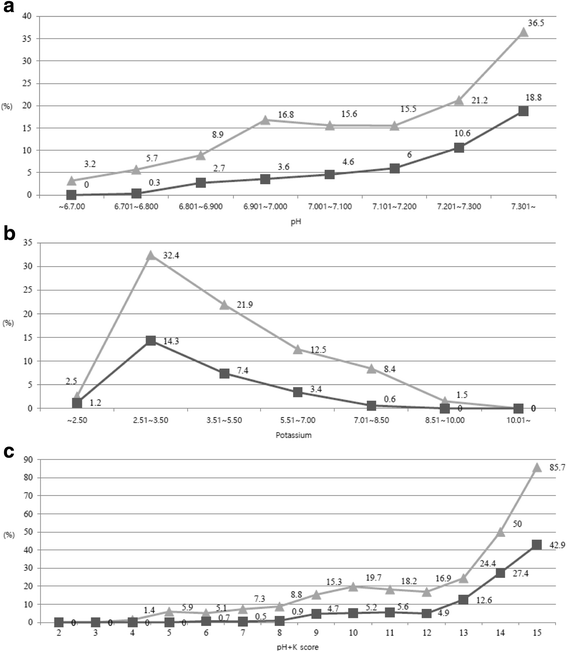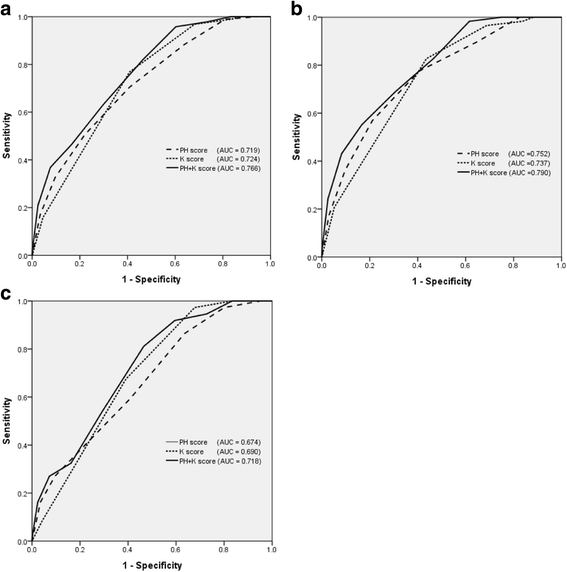Initial blood pH during cardiopulmonary resuscitation in out-of-hospital cardiac arrest patients: a multicenter observational registry-based study
- PMID: 29268775
- PMCID: PMC5740770
- DOI: 10.1186/s13054-017-1893-9
Initial blood pH during cardiopulmonary resuscitation in out-of-hospital cardiac arrest patients: a multicenter observational registry-based study
Abstract
Background: When an out-of-hospital cardiac arrest (OHCA) patient receives cardiopulmonary resuscitation (CPR) in the emergency department (ED), blood laboratory test results can be obtained by using point-of-care testing during CPR. In the present study, the relationship between blood laboratory test results during CPR and outcomes of OHCA patients was investigated.
Methods: This study was a multicenter retrospective analysis of prospective registered data that included 2716 OHCA patients. Data from the EDs of three university hospitals in different areas were collected from January 2009 to December 2014. Univariate and multivariable analyses were conducted to elucidate the factors associated with survival to discharge and neurological outcomes. A final analysis was conducted by including patients who had no prehospital return of spontaneous circulation and those who underwent rapid blood laboratory examination during CPR.
Results: Overall, 2229 OHCA patients were included in the final analysis. Among them, the rate of survival to discharge and a good Cerebral Performance Categories Scale score were 14% and 4.4%, respectively. The pH level was independently related to survival to hospital discharge (adjusted OR 6.287, 95% CI 2.601-15.197; p < 0.001) and good neurological recovery (adjusted OR 15.395, 95% CI 3.439-68.911; p < 0.001). None of the neurologically intact patients had low pH levels (< 6.8) or excessive potassium levels (> 8.5 mEq/L) during CPR.
Conclusions: Among the blood laboratory test results during CPR of OHCA patients, pH and potassium levels were observed as independent factors associated with survival to hospital discharge, and pH level was considered as an independent factor related to neurological recovery.
Keywords: Cardiopulmonary resuscitation; Out-of-hospital cardiac arrest; pH.
Conflict of interest statement
Ethics approval and consent to participate
This study was approved by the institutional review board of the Boramae Medical Center (20150709/16-2015-93/081), Bundang Seoul National University (B-1706/402-105), and Gil Medical Center (GCIRB 2016-365). Each hospital obtained approval from their respective institutional review board for data collection and follow-up of OHCA patients under the waiver of informed consent granted by the ethics committee.
Consent for publication
Not applicable.
Competing interests
The authors declare that they have no competing interests.
Publisher’s Note
Springer Nature remains neutral with regard to jurisdictional claims in published maps and institutional affiliations.
Figures




Similar articles
-
Prognostic value of venous blood analysis at the start of CPR in non-traumatic out-of-hospital cardiac arrest: association with ROSC and the neurological outcome.Crit Care. 2020 Feb 22;24(1):60. doi: 10.1186/s13054-020-2762-5. Crit Care. 2020. PMID: 32087761 Free PMC article.
-
Impact of cardiopulmonary resuscitation duration on survival from paramedic witnessed out-of-hospital cardiac arrests: An observational study.Resuscitation. 2016 Mar;100:25-31. doi: 10.1016/j.resuscitation.2015.12.011. Epub 2016 Jan 13. Resuscitation. 2016. PMID: 26774172
-
Effects of modifiable prehospital factors on survival after out-of-hospital cardiac arrest in rural versus urban areas.Crit Care. 2018 Apr 18;22(1):99. doi: 10.1186/s13054-018-2017-x. Crit Care. 2018. PMID: 29669574 Free PMC article.
-
Meta-analysis of the success rate of heartbeat recovery in patients with prehospital cardiac arrest in the past 40 years in China.Mil Med Res. 2020 Jul 7;7(1):34. doi: 10.1186/s40779-020-00263-7. Mil Med Res. 2020. PMID: 32631439 Free PMC article.
-
Head-up cardiopulmonary resuscitation.Curr Opin Crit Care. 2023 Jun 1;29(3):155-161. doi: 10.1097/MCC.0000000000001037. Epub 2023 Mar 20. Curr Opin Crit Care. 2023. PMID: 37078637 Review.
Cited by
-
[Recommendations for extracorporeal cardiopulmonary resuscitation (eCPR) : Consensus statement of DGIIN, DGK, DGTHG, DGfK, DGNI, DGAI, DIVI and GRC].Anaesthesist. 2018 Aug;67(8):607-616. doi: 10.1007/s00101-018-0473-y. Anaesthesist. 2018. PMID: 30014276 Review. German.
-
Recommendations for extracorporeal cardiopulmonary resuscitation (eCPR): consensus statement of DGIIN, DGK, DGTHG, DGfK, DGNI, DGAI, DIVI and GRC.Clin Res Cardiol. 2019 May;108(5):455-464. doi: 10.1007/s00392-018-1366-4. Epub 2018 Sep 4. Clin Res Cardiol. 2019. PMID: 30361819 Review.
-
Prognostic value of venous blood analysis at the start of CPR in non-traumatic out-of-hospital cardiac arrest: association with ROSC and the neurological outcome.Crit Care. 2020 Feb 22;24(1):60. doi: 10.1186/s13054-020-2762-5. Crit Care. 2020. PMID: 32087761 Free PMC article.
-
Association between low pH and unfavorable neurological outcome among out-of-hospital cardiac arrest patients treated by extracorporeal CPR: a prospective observational cohort study in Japan.J Intensive Care. 2020 May 11;8:34. doi: 10.1186/s40560-020-00451-6. eCollection 2020. J Intensive Care. 2020. PMID: 32426140 Free PMC article.
-
Intra-arrest blood-based biomarkers for out-of-hospital cardiac arrest: A scoping review.J Am Coll Emerg Physicians Open. 2024 Mar 18;5(2):e13131. doi: 10.1002/emp2.13131. eCollection 2024 Apr. J Am Coll Emerg Physicians Open. 2024. PMID: 38500598 Free PMC article.
References
Publication types
MeSH terms
LinkOut - more resources
Full Text Sources
Other Literature Sources

